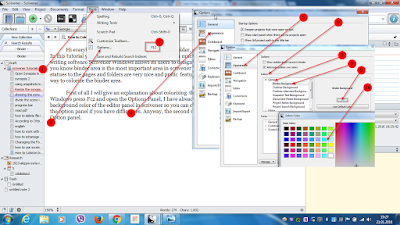

- #CHANGE PROJECT NOTES COLOR SCRIVENER WINDOWS HOW TO#
- #CHANGE PROJECT NOTES COLOR SCRIVENER WINDOWS PDF#
- #CHANGE PROJECT NOTES COLOR SCRIVENER WINDOWS ZIP FILE#
- #CHANGE PROJECT NOTES COLOR SCRIVENER WINDOWS UPDATE#
Features for academic and nonfiction writers.Scrivener lets you easily format your screenplay so you can focus on the essential elements -characters, dialogue, and action. Without the right tools, you can end up spending half your time worrying about formatting. Scrivener’s system of folders and subfolders helps you arrange and rearrange the various parts of your writing project. Enhances o An outline helps you clarify your ideas and plan your manuscript.Scrivener has many tools to help you edit more efficiently whether it’s correcting simple errors or restructuring entire sections and chapters. Simplifies Editing is an essential part of any writing project.Helps you organize long writing projects such as novels, nonfiction books, academic papers, even scripts.

Overview: Wh at Can Scrivener Do For You? Whether you ultimately choose to use Scrivener or a competing product, you owe it to yourself to learn the various features and benefits of this renowned software product for writers. This review is designed for people who are new to Scrivener as well as anyone who has an older version and may not be familiar with the update. There have been several important updates over the years and the current version, Scrivener 3, is now available for both Mac and Windows users. For quite a few years, Scrivener has been one of the leading and most comprehensive software suites made exclusively for writers. When I tested the latter, the resulting file worked perfectly on a Kindle DX ( ).If you’re a writer seeking tools to help you with tasks such as research, organization, and formatting, you’ve probably heard of Scrivener, the writing software created by Literature and Latte. In addition to PDF, RTF, and Microsoft Word exporting, Scrivener 2 can save projects as iPad-friendly ePub documents or a Kindle e-books.
#CHANGE PROJECT NOTES COLOR SCRIVENER WINDOWS PDF#
I was delighted to discover that I could now focus on compiling the contents of individual folders, sparing me from manually deselecting every file in my first through fourth drafts just to get a PDF of the fifth. Previously a crowded, intimidating monolith, it’s now a streamlined checklist of all the options necessary to turn your files into a finished manuscript. Scrivener 2 saves its biggest improvements for its Compile Draft window, one of Scrivener 1’s few weak spots.

And I especially liked the Name Generator, which spits out random character names based on a host of fun and detailed options.
#CHANGE PROJECT NOTES COLOR SCRIVENER WINDOWS ZIP FILE#
Afraid you’ll lose your work? Scrivener 2 makes automatic backups to a separate ZIP file every time you close a project. Where Scrivener 1 only let you view two documents simultaneously, fully editable pop-up Quick Reference windows now keep any files within your document easily within view. You can customize the icons that show up in the left-hand Binder column. Fans of full-screen editing can now add their own background images. (Note that this isn’t like tracking changes in Microsoft Word ( ) you can remove the color from revised text, but you can’t selectively peel back alterations you make.) Comments or footnotes within the text now appear directly in the right-hand Inspector column.Ī host of smaller features round out Scrivener 2’s appeal. With up to five layers of color-coded revisions, you can clearly show who added what, when, to which document. Scrivener 2 also simplifies editing and revising. But like nearly all of Scrivener’s features, it’s completely optional and easily hidden.
#CHANGE PROJECT NOTES COLOR SCRIVENER WINDOWS HOW TO#
I found the Collections interface confusing at first it’s hard to tell which collection you’re clicking on, or how to get to the others from whichever one you’ve called up.
#CHANGE PROJECT NOTES COLOR SCRIVENER WINDOWS UPDATE#
Placing files or folders in a collection won’t alter the project itself, and searches saved as collections will automatically update as you add new relevant documents. The new Collections let you gather subsets of documents (say, every chapter in which a certain character appears, or all your research on the city of Petra) in tabbed folders at the top of the left-hand Binder column.


 0 kommentar(er)
0 kommentar(er)
